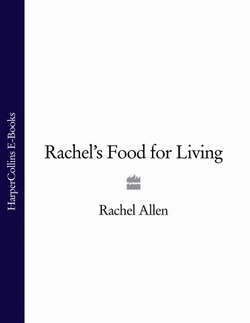Читать книгу Rachel’s Food for Living - Rachel Allen - Страница 13
ОглавлениеSlow-cooked Lamb Shanks with Piperonata
There are times when perfectly cooked lamb seems the cure for just about anything. I love lamb shanks for their tender, succulent texture and sweet, delicious flavour. They’re best cooked at a low temperature for a long time, about 3–4 hours, by which time the meat will be falling off the bone. The piperonata is a wonderful pepper and tomato stew that is very versatile. Serve it as a vegetable accompaniment to a roast as here, or with egg dishes such as omelettes. It can be made in advance and frozen. I often serve this dish with mashed potato (see page 27).
SERVES 4
FOR THE LAMB SHANKS
125g (5oz) streaky bacon, chopped into 1cm (½in) pieces
2 tbsp olive oil
4 lamb shanks
Salt and freshly ground black pepper
1 large onion, peeled and chopped
4 cloves of garlic, peeled and crushed or grated
2 stalks of celery, chopped
2 carrots, peeled and chopped
1 x 400g tin chopped tomatoes
225ml (8fl oz) red wine
225ml (8fl oz) lamb or chicken stock
2 sprigs of fresh rosemary or 4 sprigs of fresh thyme
1 bay leaf
2 strips of orange peel (removed with a peeler)
Caster sugar
FOR THE PIPERONATA
3 tbsp olive oil
1 small onion, peeled and sliced
2 cloves of garlic, peeled and crushed or grated
Salt and freshly ground black pepper
2 small red peppers
1 small yellow pepper
1 x 400g tin of chopped tomatoes or 4 large ripe tomatoes, peeled and sliced
1–2 tsp sugar
2 tbsp torn fresh basil or chopped fresh marjoram
1 First prepare the lamb shanks. Preheat the oven to 150°C (300°F), Gas mark 2.
2 Boil the bacon in boiling water in a small saucepan for 1 minute, then rinse in cold water.
3 Place an ovenproof medium–large casserole pot or heavy large saucepan on a medium heat, pour in the olive oil and put in the lamb shanks, season and allow to brown slightly on all sides. Add all the remaining ingredients, season with salt, pepper and a couple of good pinches of sugar.
4 Bring up to the boil, then place in the oven and cook for 3 hours or until very tender – the meat should be almost falling off the bone.
5 While the lamb is cooking, make the piperonata. Heat the olive oil in a medium-sized casserole or saucepan. Add the onion and garlic, season with salt and pepper and cover (see the handy tip on page 15). Allow to cook gently on a low heat until the onion is soft, about 8 minutes.
6 Meanwhile, slice the peppers. Cut the peppers into quarters from top to bottom, remove the stalk and seeds, then cut into short slices crossways or cut into squares about 3cm (1¼in).
7 When the onion is soft, add the peppers, toss to mix, replace the lid and cook for another 8 or so minutes until the peppers are very soft.
8 Add in the tomatoes and season with salt, pepper and sugar. Cook uncovered for 15–20 minutes on a low heat until the sauce has
thickened and all the vegetables are cooked. Add the chopped herbs and season to taste.
9 When the lamb is cooked, take it out of the oven. I like to remove half of the sauce and liquidise it before adding it back into the pot.
10 Season to taste and serve together with the piperonata and mashed potato or bread, or allow to cool and reheat gently the following day.
Rachel’s handy tips
To peel fresh tomatoes, cut a cross through the skin, drop them into boiling water for 10–15 seconds, then drain, cool and peel.
I sometimes add chopped chilli and fresh coriander into the piperonata instead of basil or marjoram. If I don’t have any fresh herbs to hand, I add a dollop of pesto in at the end, for that lovely basil flavour.
